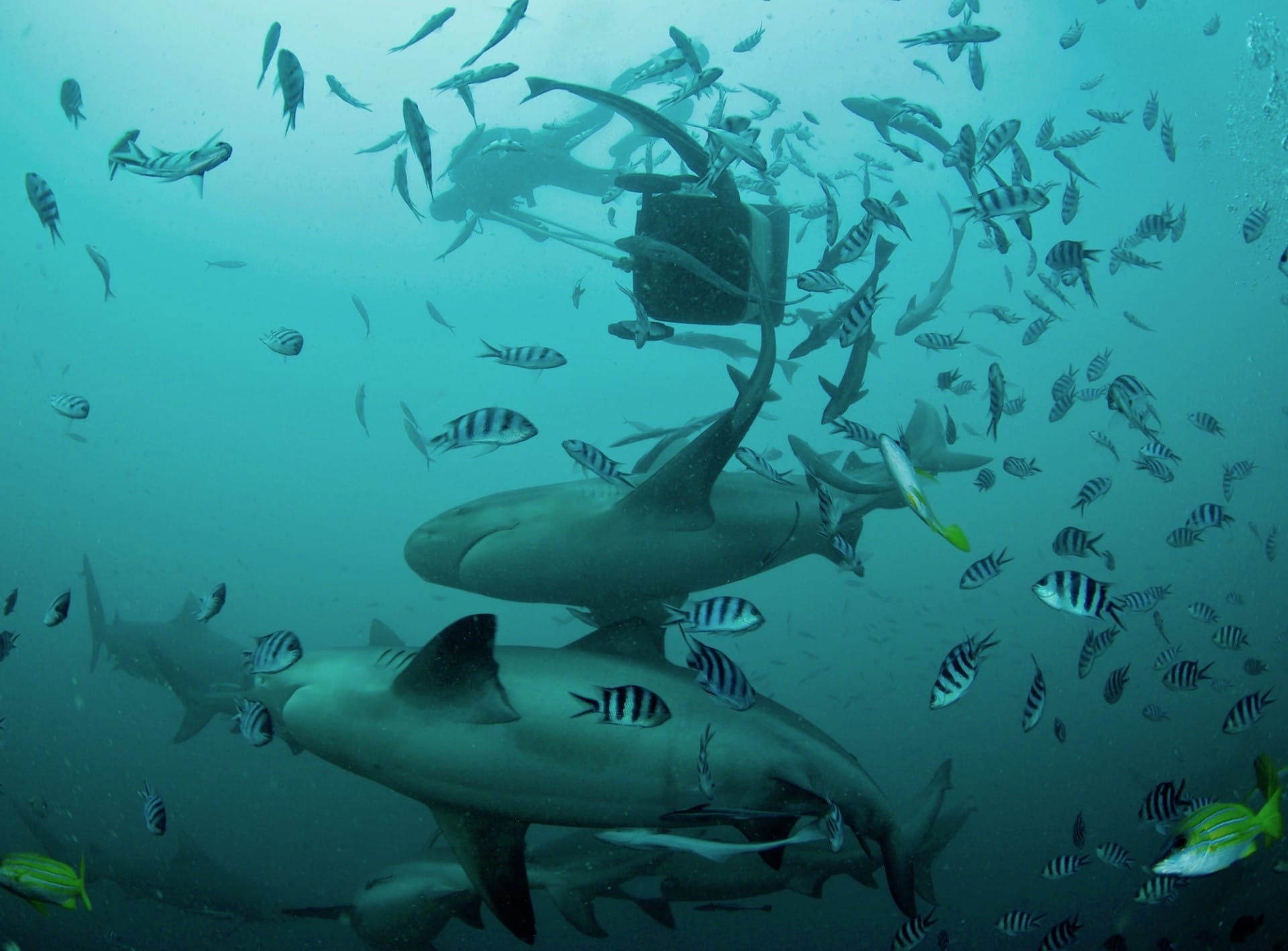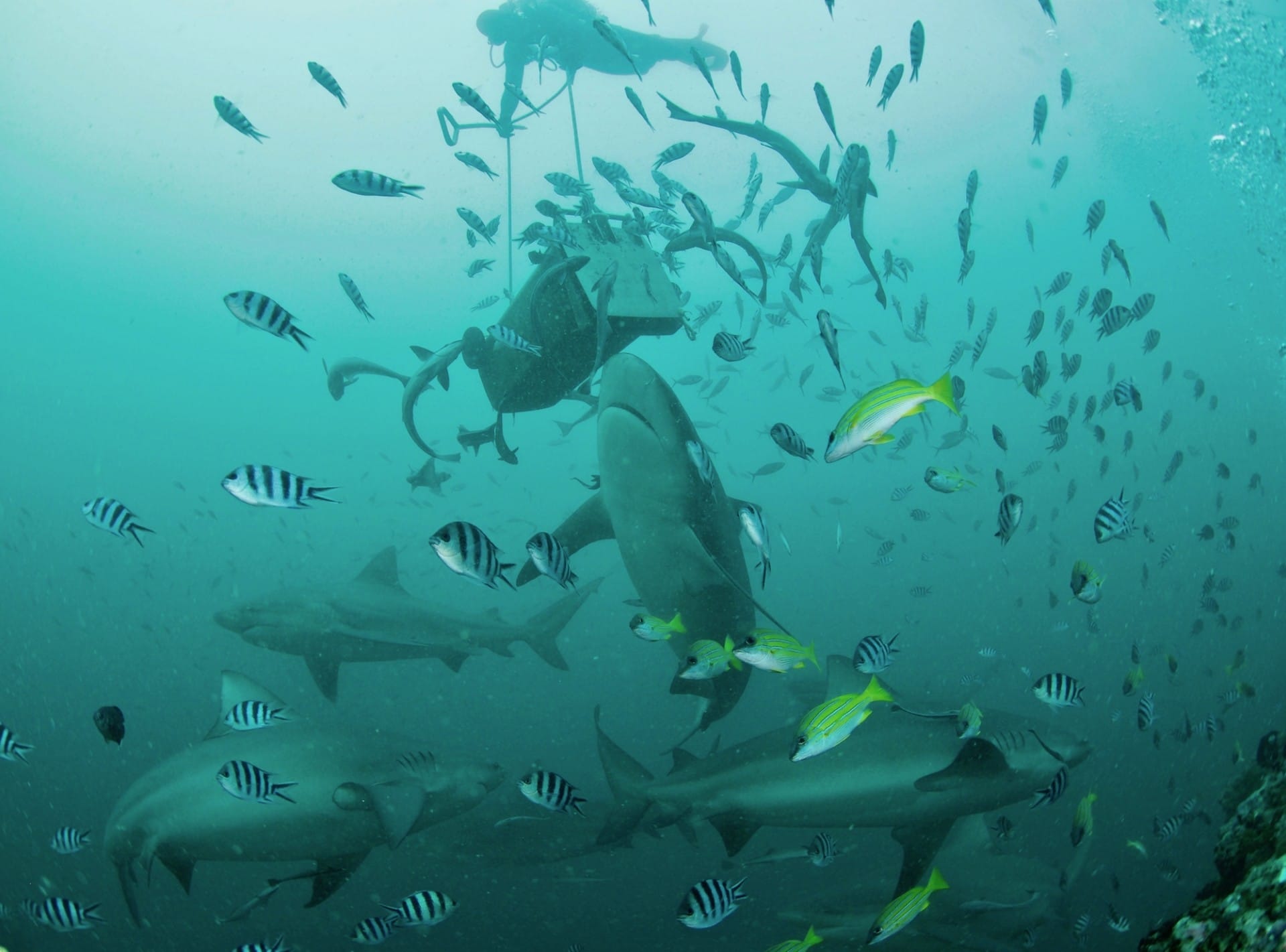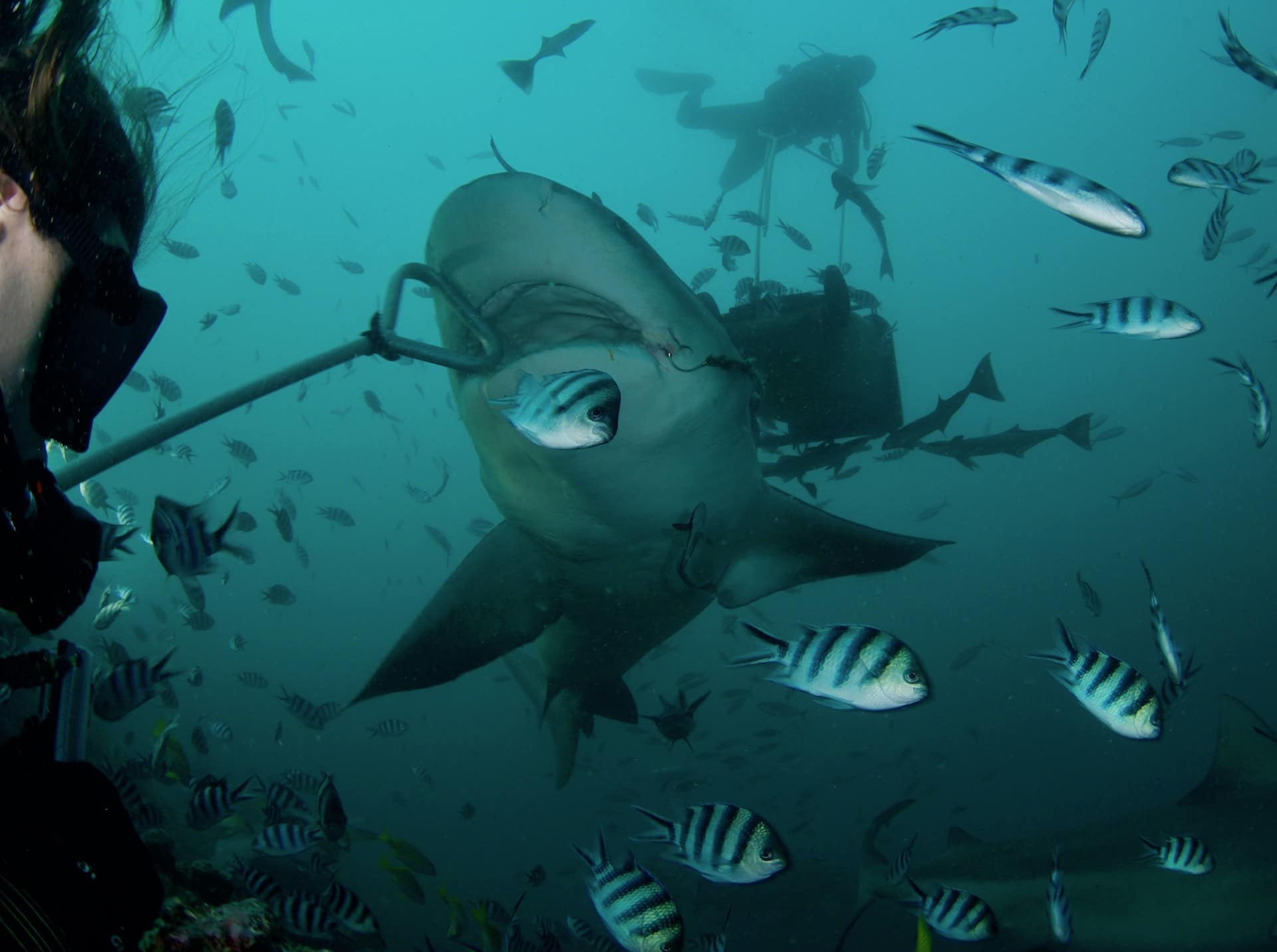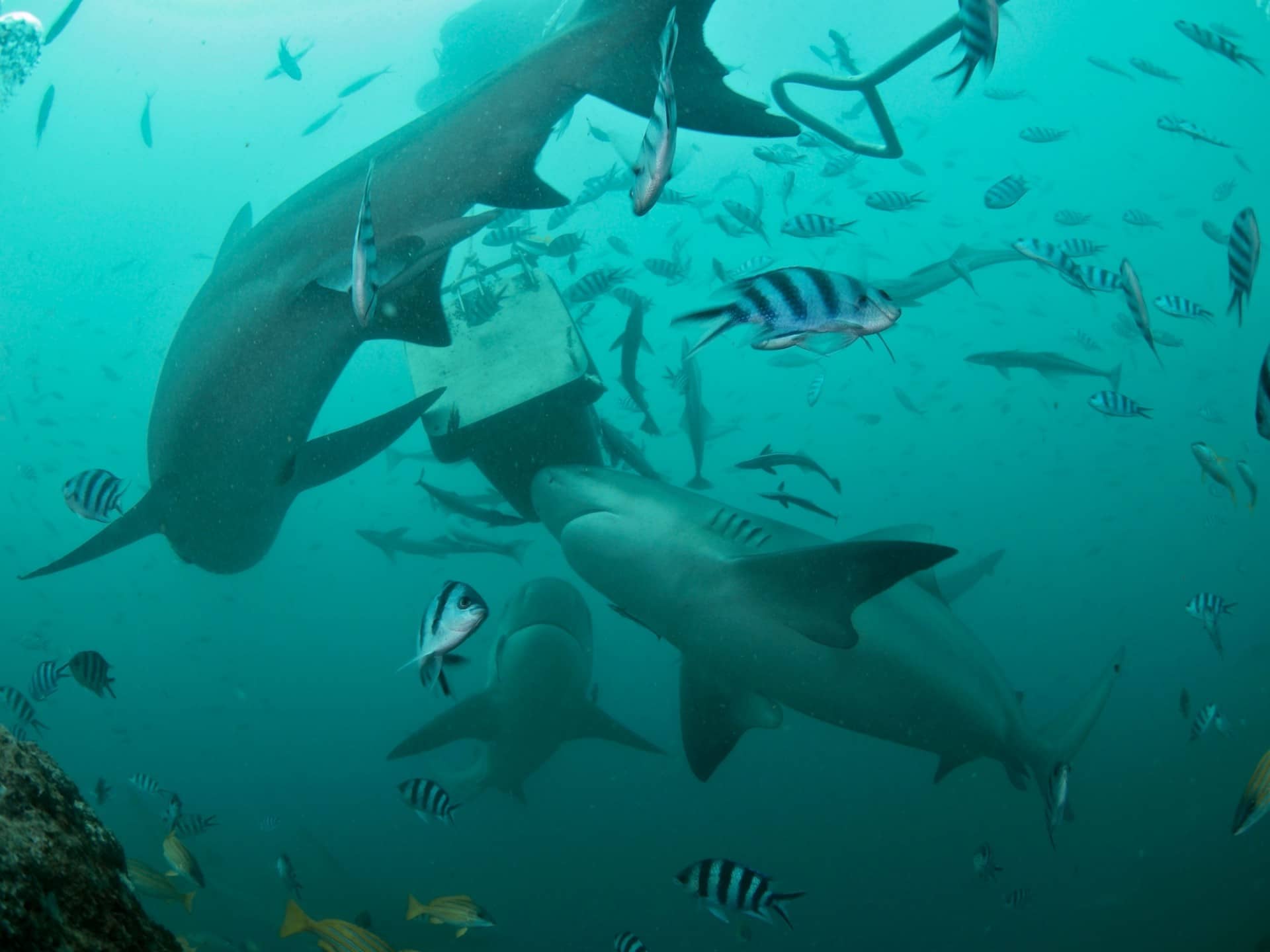News
Shark Week – Fiji: Shark Diving in murky waters (Watch Video)

For Shark Week, Scubaverse bloggers CJ and Mike share this great video and their experiences of diving with Bull sharks and more in Fiji…
Murky waters are not what usually come to mind when thinking about diving in Fiji. Unfortunately, we had timed our visit straight after the typhoon in mid-April. Having reached Viti Levu after several days delay, it was only to find that conditions were still too bad on the south coast to do any diving for a couple of days; so we contented ourselves to enjoy the beautiful island and the locals’ fantastic hospitality.
One of the dives we were most looking forward to was the famous Beqa Lagoon shark dive at the Shark Reef Marine Reserve. Being very keen on shark conservation I was interested to see how this operation worked, how it involved local people in the marine reserve and how the proceeds from tourism helped with maintaining a protected area for sharks. Luckily for us the weather settled down after a few days and we were able to book in for a shark dive!
We chose to go with Beqa Adventure Divers and booked to do two shark dives in the morning and an afternoon soft coral dive. We were greeted on arrival by a friendly and efficient front desk team and completed all the necessary paperwork. We then went through to the gear rental and equipment set-up area to get ready to dive. Here we had our only negative experience of the trip, bumping into an extremely rude man, who turned out to be one of the owners! Thankfully our interaction was a brief one and as the rest of the staff possessed the manners and professionalism sadly lacking in their boss, we moved on and did not allow this incident to ruin our whole day.
Once kitted up, our equipment was loaded onto the boat and we met our crew. The boat briefing was very good and the dive briefing thorough, with clear and precise instructions given as to where to go, when, who to follow and how to behave. The divemaster gave us strict instructions on keeping all limbs and cameras to yourself and behind the purpose built walls. The dive plan was well thought out and explained, with the aid of a dive site map. At the site we were told the visibility was likely to be lower than pictures we may have seen and to stay close to the divemaster assigned to you. We were also given a quick shark ID summary and requested to count the sharks we saw by our boat’s marine biologist. With growing excitement we kitted up and jumped in!

Once in the water we descended with our DM and took up position in front of ‘The Arena’, behind a wall built of coral rubble at 30m. Once all the divers were positioned with DMs at either end and at various points behind us with big poles, the feed began! Another DM swam above us with a wheelie bin full of tuna heads, controlling the position and timing of the dropped food so that as the Bull sharks came in they would chomp up the fish just in front and above our heads, giving a magnificent view of these huge sharks in feeding mode. For 15 minutes huge Bull sharks swam all around us, feeding and cruising past, eyeballing the group. The experience was made all the more atmospheric by the low visibility – dark shadows emerging into oncoming sharks in what felt like the last few metres!
After 15mins at depth we moved up to the next level, 10m for an another 15 minutes, to view Grey, Whitetip and Blacktip Reef sharks, which were fed fish from a smaller container by a DM. The final part of the dive was really an extended safety stop at 5m, with around 10mins to enjoy the reef sharks and abundant fish life at the top of the reef before surfacing.
With everyone buzzing about the dive we were served hot drinks and cookies on the boat, while the marine biologist took data from us, about what sharks we had seen and how many we estimated there were of each species. Apparently today was a quiet day with ‘only’ 20+ Bull sharks (they can get up to 70+ on a busy day!). He then gave us a talk on the shark species we had seen, their behaviours, and some great information about the formation of the marine reserve and their continuing projects and data collection.

After a lengthy surface interval to off-gas, we headed back in at ‘The Take Out’ to do a 15m dive for 30mins and 5m for 10mins. Here we lay on slabs of rock behind a small wall and had some even closer Bull shark action. The DM behind me occasionally had to bop a shark on the snout if it continued towards us a bit too close, but the sharks seemed very used to the routine and interested only in having a snack of tuna head. The visibility was worse on this dive, adding to the drama, but also making we wish we could experience it again in clear water. After half an hour, which seemed like only minutes with all the stunning sharky action, we headed up to safety stop depth and once again enjoyed the Reef shark feeding.
I didn’t know how I would feel about the shark dive going in, but was prepared to give it a go and I knew I would love seeing sharks in close proximity. Having done the two dive morning, I am very impressed with the set up at B.A.D. Safety wise it is excellent as the very structured dive plan contributes to the high level of control the staff have at all times. The feeding was organised to allow everyone to get a good view and close up action with the sharks, and the high ratio of DMs to divers means the staff have total control of the group and the ability to turn away any shark that gets a little too curious without any drama. Having a multi-level dive also allows divers to see several different species of shark on one dive and extend the dive time.

The staff on the boats and in the water were all locals, all of whom were knowledgable, professional and exuded a calm on a boat full of very excited tourists. I was really impressed that they had a marine biologist on each boat to provide info, take data and answer questions. Also we were told that a portion of the money from tourism goes to local communities that have given up their fishing rights in order to create and maintain the marine reserve, which is great news and a good conservation strategy.
Sadly as the weather was worsening and the vis deteriorating, the afternoon dive was called off and so we packed our things and headed off for a good lunch, all that excitement certainly works up an appetite!
On the whole, we had a really good experience with the Fiji Shark Dive in Beqa Lagoon and would recommend it to anyone who wants to see Bull sharks up close. However if you want to do lots of diving and see some of Fiji’s other world class dive sites in all their glory, I would recommend paying high season rates and travelling to Fiji outside of the typhoon season!
News
Book Review: Fire on Monroe Bravo by Fred Lockwood

Fire on Monroe Bravo is the latest book in the Jack Collier series by Fred Lockwood. Our story begins with our lead characters, Jack and Sandro, owners of Marine Salvage & Investigation Company, arriving on the Monroe Bravo Oil & Gas Platform in the North Sea. Having secured a contract for their vessel the MV Stavanger to act as support ship to the platform for TransGlobal Oil, our protagonists are on a celebratory visit.
However almost as soon as they arrive a series of explosions rock the platform, causing huge damage, loss of life and the very real danger of a massive human, ecological and financial disaster.

As the danger mounts for both our heroes and the surviving workers, Jack and Sandro will have to escape the inferno, all while trying to save the platform and the men still trapped unable to help themselves.
The disaster sets the scene for the unfolding story lines following the fate of the platform and our main characters, the police investigation into a suspected terrorist act and the actions of TransGlobal Oil as they attempt to navigate the pubic outcry and financial repercussions.
In his eighth book, Fire on Monroe Bravo, Fred Lockwood delivers an explosive thriller, with plenty of above and in-water drama, and our heroes fighting for survival, what more can you ask for?
We thoroughly recommend this read and look forward to the next in the series. For more information about his book series, you can check out the reviews of his previous books here on Scubaverse.
- Title: Fire On Monroe Bravo
- Author: Fred Lockwood
- ISBN: 979-8325324536
Available in a paperback version and for Kindle from Amazon and book stores.
Blogs
Alonissos: The complete diving destination (Part 1)

In June we were incredibly fortunate to be invited to dive in Alonissos, a small Greek Island in the Sporades island chain located in the North Aegean Sea. While I have long been a big fan of the Greek Islands as a great holiday destination, I had not had the opportunity to do any diving on previous visits and Mike and I were extremely excited to see what Alonissos had to offer both above and below the surface!

The Sporades are easily accessible via the airport in Skiathos (the first island in the chain), which is served by Jet2 flights from all major UK airports from May through October. Numerous ferries and charter boats make island hopping from Skiathos Town a breeze. After an hour boat ride, the picturesque port of Patitiri was a wonderful introduction to Alonissos, where we were met by our gracious hosts Kostas of Albedo Travel and Dias of Alonissos Triton Dive Center. Mike and I were delighted to be staying at the Paradise Hotel, aptly named for its stunning views over the sea and great location for walking to the waterfront.

Alonissos is beautifully situated in the National Marine Park of Alonissos and the Northern Sporades, the largest marine protected area in Europe. The surrounding seas offer fabulous marine life, including incredibly rare species such as the Mediterranean monk seal. They boast deep walls covered in gorgonians and sponges, stunning topography with caverns, swimthroughs and pinnacles, and the first accessible ancient shipwreck from 500BC!

In locations where historical sites have been reported, the waters are largely restricted, but with collaboration between government, underwater archeologists and dive centres, incredible underwater museums are being created for a truly unique diving experience. Alonissos is home to the first of these, the Ancient Shipwreck of Peristera Accessible Underwater Archeological Site. The chance to dive into history (along with reports of healthy reef life and amazing underwater topography) meant Mike and I were keen to get in the water.

Our introduction to the diving around Alonissos was at the Agios Georgios Pinnacles, in the channel between Alonissos and Skopelos. This fantastic site was named “The Chimney,’ and proved to have a huge amount to see. We got to a decent depth here (over 25m), and marvelled at a colourful reef wall with a wonderful swim through whose rocky walls were absolutely covered with life. As well as brilliant topography there was no shortage of macro life here. We saw numerous nudibranchs, five different species in total. The second dive at Mourtias reef nearby was a shallower dive along a nice wall with lots of crevices. Several moray eels and grouper called this site home. We enjoyed looking in the crevices for lobster and smaller benthic life, such as cup corals and tunicates.

Our itinerary allowed us two dives a day with afternoons left to explore the island with our hire car and evenings to enjoy the famous Greek hospitality. This proved to be a lovely mix of in-water and land based diversions.

The next days diving to the Gorgonian Gardens and Triton’s Cave was to be even better! These two stunning sites are nothing short of fabulous. The Gorgonian Gardens was a deep wall near to the Agios Georgios islands. The ever-present currents in this deep channel meant that the sea life was amazing … the namesake Gorgonian sea fans dotted the wall at a depth of 30 to 50 meters, getting ever larger the deeper we went. Above 30m was by no means less beautiful, with sponges, corals, scorpionfish, moray eels and some rare and colourful nudibranchs.

The second shallower dive of the day was to Triton’s Cave or the Cavern of Skopelos, on the east side of that island. The spectacular rock formations had wild striations both above and below the water making a truly epic topography. The cavern entrance was at 14m, and big enough for a buddy pair, winding up to 6m and passing two beautiful windows out into the blue. Emerging from the cavern, the light at the shallower depths and the incredible rock formations made for a fantastic gentle swimming safety stop and we all surfaced by the boat with massive grins.

Check out our next blog :Alonissos: The complete diving destination (Part 2)” to hear about our amazing dive on the 2500 year old Peristera Wreck!
Thanks to:
Alonissos Triton Dive Center https://bestdivingingreece.com/
Albedo Travel https://alonissosholidays.com/activities/
Paradise Hotel https://paradise-hotel.gr/
Alonissos Municipality https://alonissos.gr/en/
-

 Blogs2 months ago
Blogs2 months agoDiving With… Nico, Ocean Earth Travels, Indonesia
-

 News1 month ago
News1 month agoMurex Bangka Announce New Oceanfront Cottages & Beachfront Dining
-

 Blogs2 months ago
Blogs2 months agoA new idea in freediving from RAID
-

 Marine Life & Conservation1 month ago
Marine Life & Conservation1 month agoIceland issue millionaire whale hunter a licence to murder 128 vulnerable fin whales
-

 Marine Life & Conservation2 months ago
Marine Life & Conservation2 months agoThe Shark Trust Great Shark Snapshot is back
-

 News3 months ago
News3 months agoCharting New Waters; NovoScuba Goes Global with the Launch of their Revolutionary Dive Training Agency!
-

 Gear News1 month ago
Gear News1 month agoNew Suunto Ocean – a dive computer and GPS sports watch in one for adventures below and above the surface
-

 Marine Life & Conservation Blogs2 months ago
Marine Life & Conservation Blogs2 months agoBook Review: Plankton















